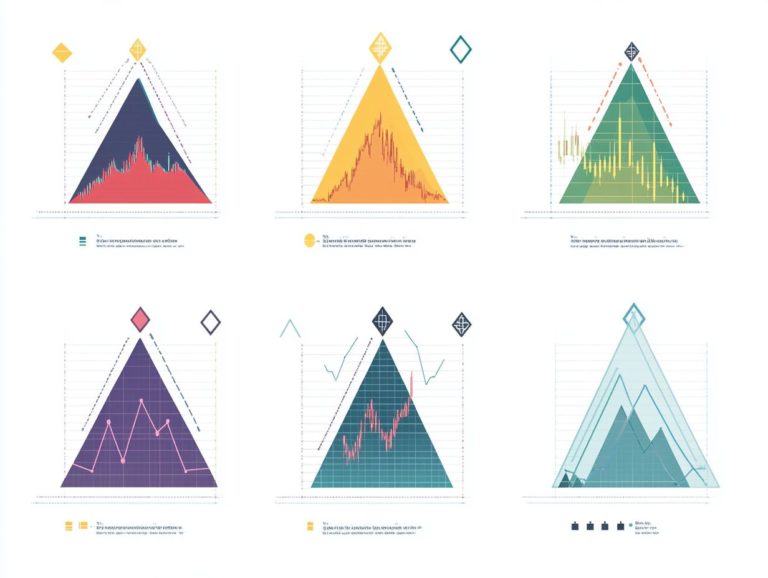Using Fibonacci Retracement in Trading
Fibonacci retracement is a powerful tool in your trading toolkit, providing valuable insights into potential support and resistance levels. By leveraging the mathematical principles of the Fibonacci sequence and the golden ratio, you can refine your entry and exit strategies, enhancing your overall trading effectiveness.
It’s crucial to avoid common pitfalls, such as overlooking other indicators or misplacing key points in your analysis. This article delves into how you can effectively utilize Fibonacci retracement, offering tips to maximize its potential and guiding you through the intricacies of this sophisticated technique.
Contents
- Key Takeaways:
- How Fibonacci Retracement is Used in Trading
- The Mathematics Behind Fibonacci Retracement
- Common Mistakes to Avoid When Using Fibonacci Retracement
- Tips for Effective Use of Fibonacci Retracement
- Frequently Asked Questions
- What is Fibonacci Retracement and How is it Used in Trading?
- How Does Fibonacci Retracement Work?
- What are the Benefits of Using Fibonacci Retracement in Trading?
- Can Fibonacci Retracement be used in any market?
- Are there any limitations to using Fibonacci Retracement?
- Is Fibonacci Retracement suitable for all types of traders?
Key Takeaways:

- Understand how the golden ratio applies to identify support and resistance.
- Use Fibonacci retracement for timing market entries and exits while considering other indicators.
- Choose the right time frame and combine Fibonacci levels with other tools for thorough market analysis.
What is Fibonacci Retracement?
Fibonacci retracement stands as a formidable tool in your technical analysis, rooted in the Fibonacci sequence a legacy of ancient mathematical insights first explored by Leonardo Fibonacci. This method enables you to pinpoint potential price reversals by leveraging specific Fibonacci levels that resonate with the golden ratio. As a result, you can establish critical support and resistance levels across various financial markets, including stocks, commodities, and EUR/USD pairs.
Fibonacci retracement connects ancient math to modern trading. This history gives context to your analysis. By applying Fibonacci levels 23.6%, 38.2%, 50%, 61.8%, and 100% to your price charts, you gain the ability to forecast potential reversal points that align seamlessly with prevailing market trends.
Understanding how these retracement levels interact with existing trends sharpens your analytical skills and enhances your capacity to formulate effective entry and exit strategies. Many savvy investors incorporate these principles into their trading plans, acutely aware of how market psychology shapes price movements at these pivotal Fibonacci thresholds.
How Fibonacci Retracement is Used in Trading
Fibonacci retracement serves as a valuable tool for traders, allowing you to identify precise entry orders, stop-loss levels, and price targets. By carefully analyzing the retracement levels derived from Fibonacci ratios, you can enhance your ability to anticipate market trends and potential reversals with greater accuracy.
Identifying Support and Resistance Levels
Identifying support and resistance levels is essential for your trading success, and Fibonacci retracement levels act as significant markers indicating where these levels might be. This knowledge allows you to align your strategies seamlessly with prevailing market trends.
When you plot Fibonacci retracement levels on your charts, you can pinpoint potential areas where prices may reverse or consolidate, granting you valuable insights for your trading decisions. For example, if you observe a sharp market movement, after a rally, the price often pulls back to the 61.8% retracement level historically a zone where buying interest tends to surge.
The 61.8% level serves as a support zone and complements your other trading strategies, such as integrating moving averages to refine your decision-making process. Utilizing visual aids like annotated charts can further illuminate these critical levels, making it easier for you to adapt your approach based on dynamic shifts in the market.
Timing Entry and Exit Points
Timing your entry and exit points is crucial for successful trading. Fibonacci retracement can help identify the perfect moments to place entry orders or set stop-loss levels. Analyzing price targets helps you make informed decisions.
Using these retracement levels lets you see when the market might reverse or continue its current path. This sharpens your decision-making process. It s essential to set stop-loss orders strategically; they act as a protective barrier against unexpected market fluctuations, ensuring that your losses are kept to a minimum.
Incorporating these strategies significantly enhances your trade execution. Staying alert to overall market conditions and combining Fibonacci analysis with other indicators helps you develop a more robust trading plan, leading to improved risk management and greater potential returns.
The Mathematics Behind Fibonacci Retracement

The mathematics of Fibonacci retracement is rooted in the Fibonacci sequence and the golden ratio. This concept helps illuminate the complex mathematical relationships that dictate patterns in financial markets, particularly in price movements.
Understanding the Golden Ratio
The golden ratio, often represented as ‘Phi’ and approximately 1.618, is a key element in the Fibonacci sequence. It plays an essential role in predicting market behavior and price movements through Fibonacci retracement levels.
This remarkable mathematical concept has captivated scholars, artists, and traders for centuries because of its presence in nature, architecture, and financial markets. Its roots trace back to ancient civilizations, including the Greeks, who elegantly incorporated the golden ratio into architectural marvels like the Parthenon.
In trading, you can leverage Fibonacci retracement levels grounded in the golden ratio to pinpoint potential reversal points in price movements. For instance, if a stock undergoes a significant rally, look to key retracement levels such as 38.2%, 50%, and 61.8% to refine your entry and exit strategies. This approach enables you to make more informed decisions, especially in volatile market conditions.
Common Mistakes to Avoid When Using Fibonacci Retracement
When you use Fibonacci retracement in trading, avoid common pitfalls to stay on top of your trading game! Misunderstandings can significantly impact your trading decisions and outcomes, so staying vigilant is key to your success.
Overlooking Other Indicators
A common mistake you might encounter as a trader is overlooking other indicators alongside Fibonacci retracement. This oversight can distort your view of market trends, ultimately influencing your decision-making in less than favorable ways.
A more effective trading strategy involves integrating Fibonacci retracement levels with various technical indicators, such as moving averages or the RSI. Doing this allows deeper insights into potential entry and exit points while accurately assessing market momentum. This holistic approach reinforces the validity of your trading signals and enhances your risk management.
Disregarding complementary tools may leave you vulnerable to false breakouts or unexpected trend reversals, leading to unanticipated losses. Understanding the synergy between these elements is crucial for crafting a well-rounded and resilient trading strategy in any market environment.
Using Incorrect Points for Analysis
Using incorrect points for analysis in Fibonacci retracement can lead you astray, resulting in misleading signals and poorly informed trading decisions. This highlights the importance of precise calculations and careful selection of high and low points.
Precision is crucial because even a minor miscalculation can divert you down a misguided path, undermining your entire trading strategy. Make sure to reference well-defined swing highs and swing lows to stay ahead in your trading game! Be mindful of the time frame you re examining, as different time frames can yield distinct Fibonacci levels.
Incorporating a mix of technical indicators can further solidify your findings and enhance your decision-making process. By approaching Fibonacci retracement with diligence, you can significantly boost the likelihood of accurately forecasting market movements.
Tips for Effective Use of Fibonacci Retracement

To truly harness the full potential of Fibonacci retracement in your trading endeavors, consider using a range of strategies that enable you to seamlessly integrate this powerful tool with other technical indicators. Doing so allows you to adeptly adapt to ever-changing market trends and enhance your overall trading experience.
Choosing the Right Time Frame
Choosing the right time frame is essential when utilizing Fibonacci retracement; different frames can reveal unique insights into market trends and potential price movements.
When deciding between day trading and swing trading, it s crucial to analyze market conditions and the inherent volatility each time frame presents. For instance, day traders often prefer short time frames like 1-minute or 5-minute charts to seize quick price movements. In contrast, swing traders typically opt for daily or weekly charts, aiming to capture larger price swings over several days or even weeks.
By understanding the advantages of each approach and selecting the time frame that best suits your strategy, you can significantly enhance your trading performance. This enables improved risk management and more precise entry and exit points based on thorough time analysis.
Combining with Other Technical Indicators
Combining Fibonacci retracement with other technical indicators can significantly enhance your trading strategies, offering a more comprehensive perspective on market trends and price movements.
Integrating tools like moving averages, MACD, or RSI with Fibonacci levels uncovers deeper insights into the strength and potential reversals of a prevailing trend. For example, if a Fibonacci retracement level coincides with a significant moving average, it can signal a stronger support or resistance point.
Observing divergence with the RSI alongside these retracement levels can indicate a possible price reversal, providing further validation for your trading decisions. Employing multiple indicators in harmony equips you to navigate the complexities of the market with greater confidence.
Frequently Asked Questions
What is Fibonacci Retracement and How is it Used in Trading?
Fibonacci Retracement is a technical analysis tool used to identify potential levels of support and resistance in a market. Based on the Fibonacci sequence, it helps traders determine entry and exit points for trades.
How Does Fibonacci Retracement Work?

This tool is based on key ratios derived from the Fibonacci sequence: 23.6%, 38.2%, 50%, 61.8%, and 100%. These levels are drawn on a chart to identify potential areas of support and resistance, guiding traders in planning their trades.
What are the Benefits of Using Fibonacci Retracement in Trading?
Fibonacci Retracement can help traders identify key levels of support and resistance, allowing for more informed trading decisions. It can also assist in determining potential profit targets and stop-loss levels.
In conclusion, applying the principles of Fibonacci retracement effectively can enhance your trading strategies. Embrace this powerful tool and elevate your trading game!
Can Fibonacci Retracement be used in any market?
Yes, you can use Fibonacci Retracement in any market. This includes stocks, forex, commodities, and cryptocurrencies. It works best on charts that show a clear trend.
Are there any limitations to using Fibonacci Retracement?
Fibonacci Retracement is powerful but not foolproof. It works best when combined with other technical indicators and fundamental analysis. It may struggle in choppy or volatile markets.
Is Fibonacci Retracement suitable for all types of traders?
This tool is suitable for both beginners and seasoned traders. Make sure to understand its mechanics and practice on a demo account before trading live. Get started now with Fibonacci and enhance your trading strategy!





